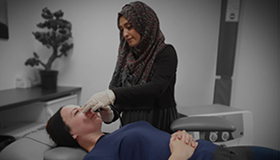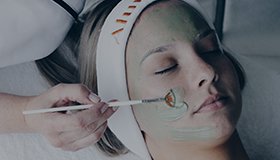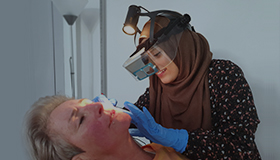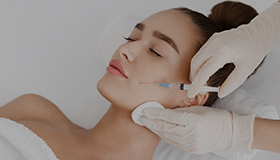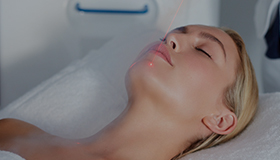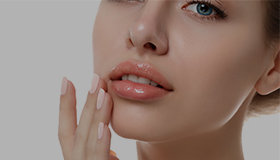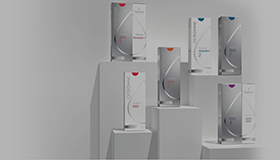ACNE & ACNE SCARRING
Acne is a common skin condition that affects most people at some point. It causes spots, oily skin and sometimes skin that’s hot or painful to touch.
Acne scarring can sometimes develop as a complication of acne. Any type of acne spot can lead to scarring, but it’s more common when the most serious types of spots (nodules and cysts) burst and damage nearby skin.
SYMPTOMS OF ACNE & ACNE SCARRING
Acne most commonly develops on the:
- Face: This affects almost everyone with acne.
- Back: This affects more than half of people with acne.
- Chest: This affects about 15% of people with acne.
TYPES OF SPOTS
There are 6 main types of spot caused by acne:
- Blackheads: small black or yellowish bumps that develop on the skin; they’re not filled with dirt, but are black because the inner lining of the hair follicle produces colour.
- Whiteheads: have a similar appearance to blackheads, they may be firmer and will not empty when squeezed.
- Papules: small red bumps that may feel tender or sore.
- Pustules: similar to papules, but have a white tip in the centre, caused by a build-up of pus.
- Nodules: large hard lumps that build up beneath the surface of the skin and can be painful.
- Cysts: the most severe type of spot caused by acne; they’re large pus-filled lumps that look similar to boils and carry the greatest risk of causing permanent scarring.
Scarring can also occur if you pick or squeeze your spots, so it’s important not to do this. There are 3 main types of acne scars:
- Ice pick scars: small, deep holes in the surface of your skin that look like the skin has been punctured with a sharp object.
- rolling scars: caused by bands of scar tissue that form under the skin, giving the surface of the skin a rolling and uneven appearance.
- boxcar scars: round or oval depressions, or craters, in the skin.
CAUSES OF ACNE AND ACNE SCARRING
Acne is most commonly linked to the changes in hormone levels during puberty, but can start at any age. Certain hormones cause the grease-producing glands next to hair follicles in the skin to produce larger amounts of oil (abnormal sebum). This abnormal sebum changes the activity of a usually harmless skin bacterium called P. acnes, which becomes more aggressive and causes inflammation and pus. The hormones also thicken the inner lining of the hair follicle, causing blockage of the pores. Cleaning the skin does not help to remove this blockage.
Other possible causes of acne and acne scarring:
- Acne is known to run in families. If both your mother and father had acne, it’s likely that you’ll also have acne.
- Hormonal changes, such as those that occur during the menstrual cycle or pregnancy, can also lead to episodes of acne in women.
- There’s no evidence that diet, poor hygiene or sexual activity play a role in acne.
Acne is caused when tiny holes in the skin, known as hair follicles, become blocked. Sebaceous glands are tiny glands found near the surface of your skin. The glands are attached to hair follicles, which are small holes in your skin that an individual hair grows out of. Sebaceous glands lubricate the hair and the skin to stop it drying out. They do this by producing an oily substance called sebum. In acne, the glands begin to produce too much sebum. The excess sebum mixes with dead skin cells and both substances form a plug in the follicle. If the plugged follicle is close to the surface of the skin, it bulges outwards, creating a whitehead. Alternatively, the plugged follicle can be open to the skin, creating a blackhead. Normally harmless bacteria that live on the skin can then contaminate and infect the plugged follicles, causing papules, pustules, nodules or cysts.
TESTOSTERONE
Teenage acne is thought to be triggered by increased levels of a hormone called testosterone, which occurs during puberty. The hormone plays an important role in stimulating the growth and development of the penis and testicles in boys and maintaining muscle and bone strength in girls. The sebaceous glands are particularly sensitive to hormones. It’s thought that increased levels of testosterone cause the glands to produce much more sebum than the skin needs.
ACNE IN FAMILIES
Acne can run in families. If your parents had acne, it’s likely that you’ll also develop it. One study has found that if both your parents had acne, you’re more likely to get more severe acne at an early age. It also found that if one or both of your parents had adult acne, you’re more likely to get adult acne too.
ACNE IN WOMEN
Women are more likely to have adult acne than men. It’s thought that many cases of adult acne are caused by the changes in hormone levels that many women have at certain times.
These times include:
- Periods: some women have a flare-up of acne just before their period
- Pregnancy: many women have symptoms of acne at this time, usually during the first 3 months of their pregnancy
- Polycystic ovary syndrome: a common condition that can cause acne, weight gain and the formation of small cysts inside the ovary
OTHER TRIGGERS
Other possible triggers of an acne flare-up include:
- some cosmetic products: however, this is less common as most products are now tested, so they do not cause spots (non-comedogenic)
- certain medications: such as steroid medicines, lithium (used to treat depression and bipolar disorder) and some drugs used to treat epilepsy
- regularly wearing items that place pressure on an affected area of skin, such as a headband or backpack
- smoking: which can contribute to acne in older people
ACNE MYTHS
Despite being one of the most widespread skin conditions, acne is also one of the most poorly understood. There are many myths and misconceptions about it:
- ‘Acne is caused by a poor diet’. So far, research has not found any foods that cause acne. Eating a healthy, balanced diet is recommended because it’s good for your heart and your health in general.
- ‘Acne is caused by having dirty skin and poor hygiene’. Most of the biological reactions that trigger acne occur beneath the skin, not on the surface, so the cleanliness of your skin has no effect on your acne. Washing your face more than twice a day could just aggravate your skin.
- ‘Squeezing blackheads, whiteheads and spots is the best way to get rid of acne’ . This could actually make symptoms worse and may leave you with scarring.
- ‘Sexual activity can influence acne’. Having sex or masturbating will not make acne any better or worse.
- ‘Sunbathing, sunbeds and sunlamps help improve the symptoms of acne’. There’s no conclusive evidence that prolonged exposure to sunlight or using sunbeds or sunlamps can improve acne. Many medicines used to treat acne can make your skin more sensitive to light, so exposure could cause painful damage to your skin, and also increase your risk of skin cancer.
- ‘Acne is infectious’. You cannot pass acne on to other people.
PREVENTION OF ACNE & ACNE SCARRING
These self-help techniques may be useful:
- Do not wash affected areas of skin more than twice a day. Frequent washing can irritate the skin and make symptoms worse.
- Wash the affected area with a mild soap or cleanser and lukewarm water. Very hot or cold water can make acne worse.
- Do not try to “clean out” blackheads or squeeze spots. This can make them worse and cause permanent scarring.
- Avoid using too much make-up and cosmetics. Use water-based products that are described as non-comedogenic. This means the product is less likely to block the pores in your skin.
- Completely remove make-up before going to bed.
- If dry skin is a problem, use a fragrance-free water-based emollient.
- Regular exercise cannot improve your acne, but it can boost your mood and improve your self-esteem. Shower as soon as possible once you finish exercising as sweat can irritate your acne.
- Wash your hair regularly and try to avoid letting your hair fall across your face.
BOOK A COMPLIMENTARY CONSULTATION
Have tried several clinics around Bristol ,all the well known ones but this is the best one ! Would recommend and will definitely be going back.
Best experience! Everyone was very friendly and have already seen a vast improvement to my skin after one treatment.
I had a facial peel this evening with Kiswa. What a lovely experience, professional, relaxing and my skin feels fantastic. I’ll definitely be back.
Thank a lot…you are the best… Highly recommend…
Would definately recommend! Highly professional… Great results too. 👍 Will be going back for sure!!
POPULAR TREATMENTS AT DERMALOGIC AESTHETICS















